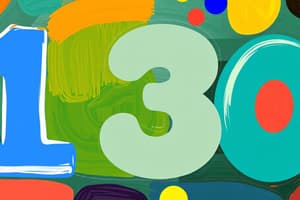Podcast
Questions and Answers
Quin tipus de patró es representa típicament amb cercles concèntrics al voltant d'un punt?
Quin tipus de patró es representa típicament amb cercles concèntrics al voltant d'un punt?
- Un patró en forma de diana (correct)
- Un patró aleatori
- Un patró geomètric
- Un patró de repetició
Què ajuda el reconeixement de patrons a desenvolupar en els nens?
Què ajuda el reconeixement de patrons a desenvolupar en els nens?
- La seva coordinació motora
- La seva intel·ligència emocional
- Les seves habilitats cognitives (correct)
- La seva creativitat
Què és la correspondència un a un en el context del recompte?
Què és la correspondència un a un en el context del recompte?
- Connectar cada paraula de recompte a un objecte diferent
- No connectar les paraules de recompte als objectes
- Connectar les paraules de recompte als objectes de manera aleatòria
- Connectar cada paraula de recompte a un objecte únic (correct)
Com ajuda el reconeixement de patrons en l'àlgebra?
Com ajuda el reconeixement de patrons en l'àlgebra?
Què significa l'estructura en el context de les matemàtiques?
Què significa l'estructura en el context de les matemàtiques?
Quina afirmació sobre el recompte i la subitització és correcta?
Quina afirmació sobre el recompte i la subitització és correcta?
Quina d'aquestes afirmacions sobre els patrons descrits al text és falsa?
Quina d'aquestes afirmacions sobre els patrons descrits al text és falsa?
Quin d'aquests exemples no il·lustra un patró creixent?
Quin d'aquests exemples no il·lustra un patró creixent?
Quina forma geomètrica es menciona sovint com a exemple de patró simètric?
Quina forma geomètrica es menciona sovint com a exemple de patró simètric?
Quan s'introdueix habitualment el concepte de patrons concèntrics?
Quan s'introdueix habitualment el concepte de patrons concèntrics?
Quina afirmació descriu millor la importància dels patrons en les matemàtiques inicials?
Quina afirmació descriu millor la importància dels patrons en les matemàtiques inicials?
Quina de les següents progressions aritmètiques no és un exemple de patró creixent?
Quina de les següents progressions aritmètiques no és un exemple de patró creixent?
Flashcards are hidden until you start studying
Study Notes
Patterns and Structure in Early Math
Mathematics is more than just numbers and calculations; it's about patterns and structure. These concepts are crucial in early math education as they help children develop a strong foundation for understanding mathematical principles later on.
Patterns
Patterns play a vital role in mathematics, especially in the early stages of learning. They follow predictable rules that allow us to anticipate what will come next. Children naturally gravitate towards patterns because they provide a sense of order and routine in their world.
Repeating Patterns
Repeating patterns are sequences where elements repeat after regular intervals. For example, counting numbers like "one, two, three, four" is a repeating pattern. Similarly, sequences like "red, green, red, green" or "circle, square, circle, square" are also examples of repeating patterns.
Growing Patterns
Growing patterns increase by one element each time. An example of this would be adding one more object to a collection each time. For instance, starting with "one apple," we can add another apple every time to form a growing sequence such as "one apple, two apples, three apples."
Symmetrical Patterns
Symmetrical patterns have parts that mirror each other. This concept is often introduced through geometric shapes, particularly those that exhibit symmetry, such as circles, triangles, or squares.
Concentric Patterns
Concentric patterns involve layers that surround a central point or shape. A classic example is the series of concentric circles drawn around a single dot, which forms a target-like pattern.
Learning these types of patterns helps children develop their cognitive abilities, including memory, sequencing, and logical reasoning. By identifying and creating patterns, children begin to understand the underlying rules and structures involved in various mathematical concepts.
Structure
Structure refers to the organization and arrangement of elements within a mathematical context. It's about understanding how parts fit together and how they relate to each other.
Number Counting and Subitizing
Counting and subitizing are essential skills in early math education. Children learn to recite number words in the correct order and connect them to written numerals. They also practice one-to-one correspondence, which means connecting exactly one counting word to exactly one object. This skill requires both matching moments of time when the action occurs and words are spoken, as well as spatial matching where the counting action points to an object once and only once.
Algebra
Algebra is introduced later in mathematics education but still relies heavily on pattern recognition and structure understanding. It involves manipulating symbols and equations to solve problems. Pattern recognition skills are crucial here, especially when dealing with mathematical expressions like addition, subtraction, multiplication, or division.
In conclusion, patterns and structures play a significant role in early math education. They help children understand the predictability and organization inherent in numerical sequences and geometrical shapes. By focusing on these concepts, educators can foster strong foundational skills that will benefit students throughout their mathematical journey.
Studying That Suits You
Use AI to generate personalized quizzes and flashcards to suit your learning preferences.




